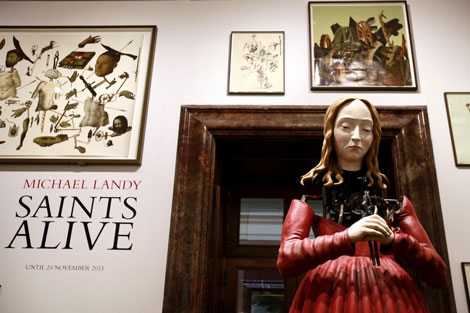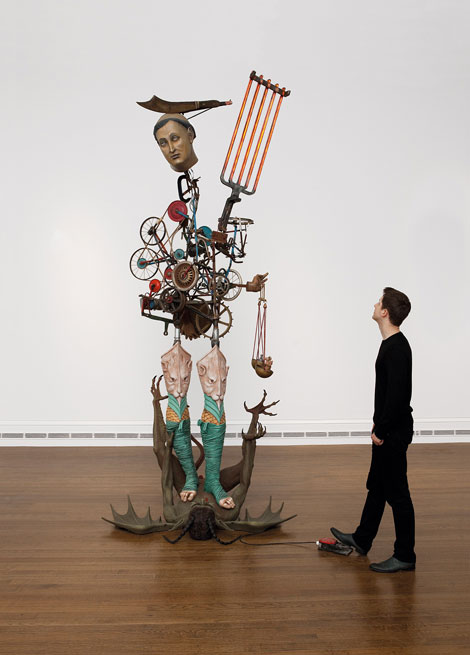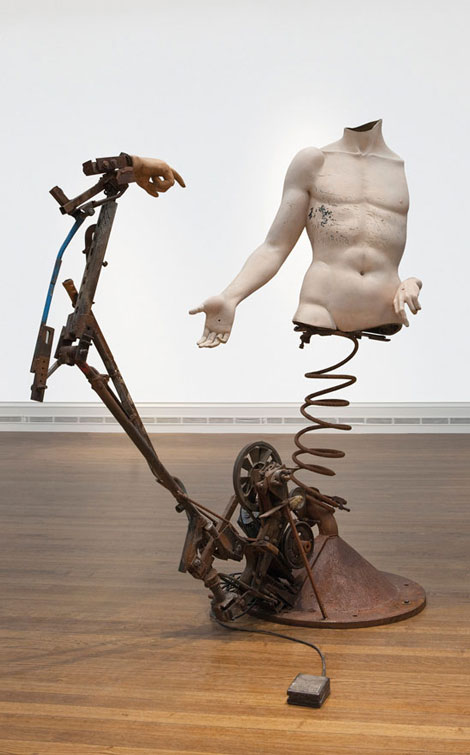Michael Landy is hardly the kind of artist you would expect to see named artist in residence at London’s National Gallery. For one thing, he’s a charter member of the Young British Artists made famous by Damien Hirst’s legendary “Freeze” exhibition. Known for their grand gestures and conceptual contrarianism, the YBAs also took a famously entrepreneurial approach to art making. But Landy was after something different. His famous 2001 work, Break Down, is the ultimate anti-materialism statement. Having assembled all his worldly possessions, from his birth certificate to his car (and a painting from fellow Goldsmiths student Hirst) in an empty department store in the heart of London, he catalogued all 7,227 items, then destroyed them in assembly line fashion using a conveyor belt, shredding machine, granulator and 12 assistants in a process that took over two weeks.
So how does Landy’s particular brand of art jibe with one of the bastions of Western European painting? Despite the fact that even Landy himself thought the National Gallery had made a mistake when he was informed he’d been chosen as artist in residence, the answer is very well.
Before his selection, Landy claims he had never been inside the museum—an irrelevant dinosaur as far as the Goldsmiths crowd was concerned. But he quickly made up for it, going through the collection meticulously, room-by-room looking at every painting. It was during this process, that he discovered a plethora of saints, particularly Saint Catherine (of whom there are 35). This would not be a surprise to anyone familiar with art history, which is so closely tied to the Roman Catholic Church, but to Landy it was a revelation.
A longstanding admirer of Jean Tinguely’s kinetic, self destructing sculptures, Landy struck on the idea of joining Tinguely with Renaissance art as a novel means of engaging with the National Gallery’s collection, while blowing fresh air into it.
The first thing you notice standing in line waiting to get in to Landy’s “Saints Alive,” is the noise. Great crashes periodically emanate from behind the glass doors that seal the installation off from the rest of the museum. It’s a surprising phenomenon in this hushed temple of art. As you draw closer to the front of the queue, you spy a large statue of a woman dressed in red. She looks authentically Northern Renaissance except for her size (7.5’) and the fact that there’s a gap at her upper torso exposing an assemblage of wheels and gears. She’s Saint Apollonia from Lucas Cranach the Elder’s Saints Genevieve and Apollonia, who holds a pincer with a tooth. For her martyrdom, all Apollonia’s teeth were pulled, and at the press of a button, Landy’s saint rams the pincers into her face. Visiting the show a month in, the sculpture’s face was already badly scarred by repeated blows.
It’s a macabre funhouse inside the show. Drop a coin in the wickedly droll Donation Box and Saint Francis bops himself on the head with his crucifix. St. Jerome whose torso, arm and lower half are separated by a scrapheap of moving parts is the source of the crashing noise. When a visitor steps on a pedal, St. Jerome slams a rock into his chest. Really hard. The effect is unsettling, it’s kind of funny and also kind of shocking, and though I wanted to see what each sculpture did, I really didn’t want to be the one stepping on the pedal. An equally brutal Doubting Thomas features a disembodied hand mercilessly poking Christ’s flesh, sending a shower of fiberglass particles to the floor.
Landy has lifted fragments from different paintings to cobble together his Frankenstein saints, monumentalizing them and turning what were flat, static works into animated sculptures. The fiberglass bodies and body parts have just the right ecclesiastical garishness, reminiscent of old-fashioned religious figurines.
Looking at the works on paper, it’s clear this use of fragments is actually an important theme of the show. Many of the paintings Landy draws from are fragments themselves, a single panel from a triptych, for instance. And the collection itself is a somewhat patchy representation of the history of art, containing only those things that, for one reason or another, survived through the ages.
Landy’s, collages made from large-scale representations of paintings augmented with drawn Tinguelyesque mechanisms are wonderful. I particularly liked Saint Apollonia (de-faced) in which Landy anticipates the scars from the bashing with the pinchers, making the image not about her martyrdom, but about his sculpture, and Saint Catherine Wheel Dump.
But the show is really about the sculptures. Violent, overwrought and self-destructive they present religious lore literally to disturbing effect. Landy has made the saints’ stories immediate and the art accessible, because there’s nothing like watching it intentionally self-destruct, to knock the preciousness out of it. Landy wants to jolt National Gallery visitors out of their museum-going passivity; perhaps even provoking them to go back and look at the pictures that inspired his work.
With Saints Alive, Landy has shown (and learned) that far from being irrelevant, the art of the past can provide a wellspring of inspiration for contemporary artists. Kudos to the National Gallery for going out on a limb and giving him the opportunity to do so.
“Saints Alive” runs through Nov. 24.
www.nationalgallery.org.uk





















0 Comments